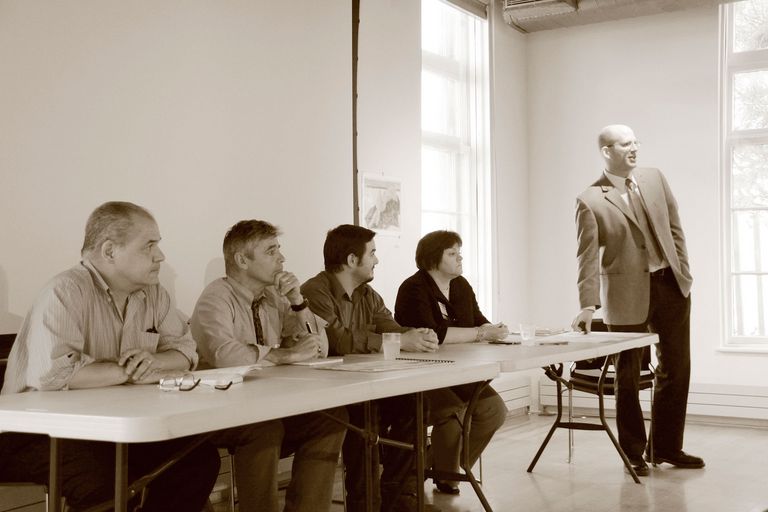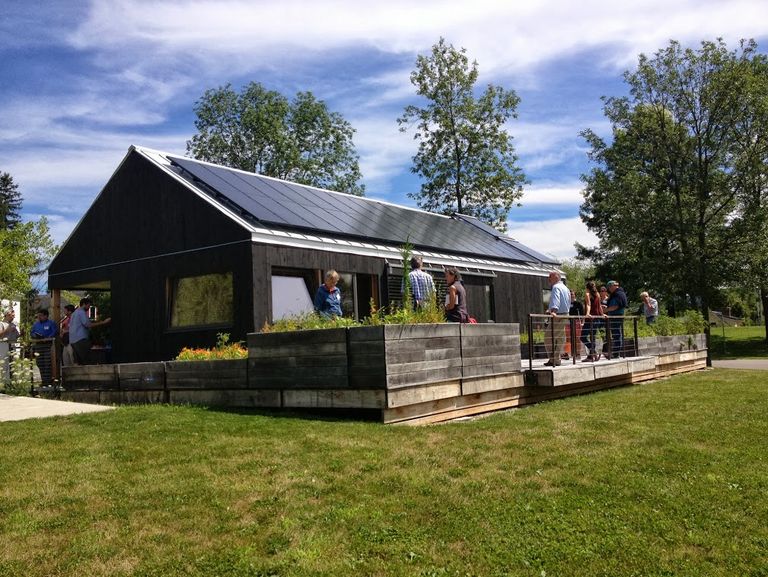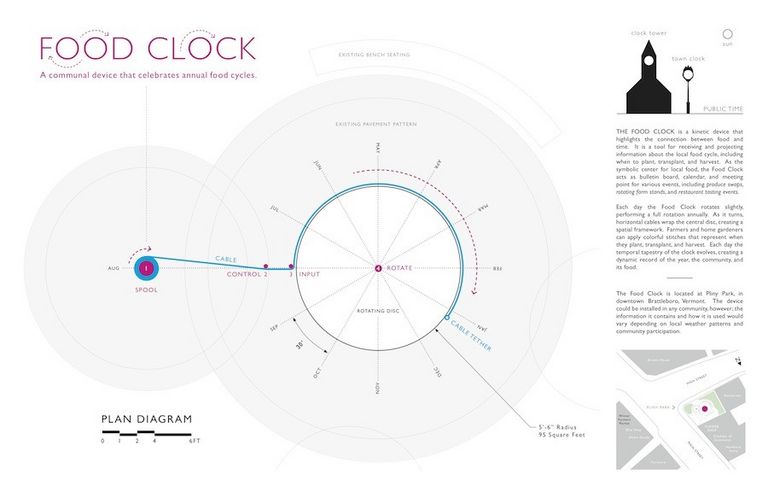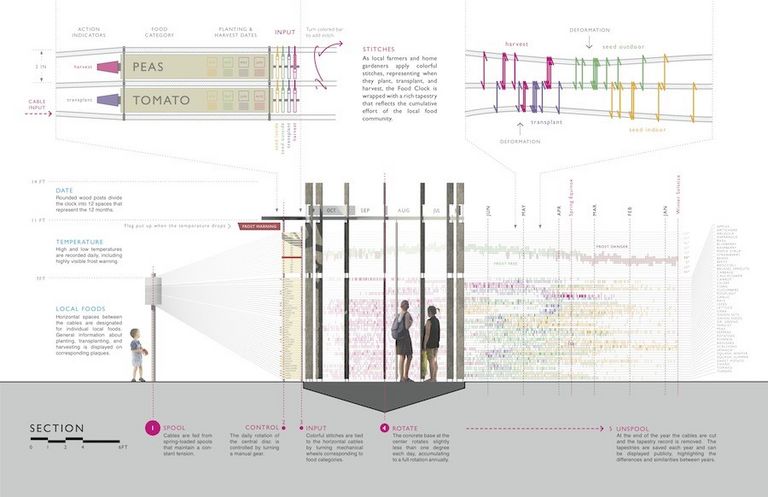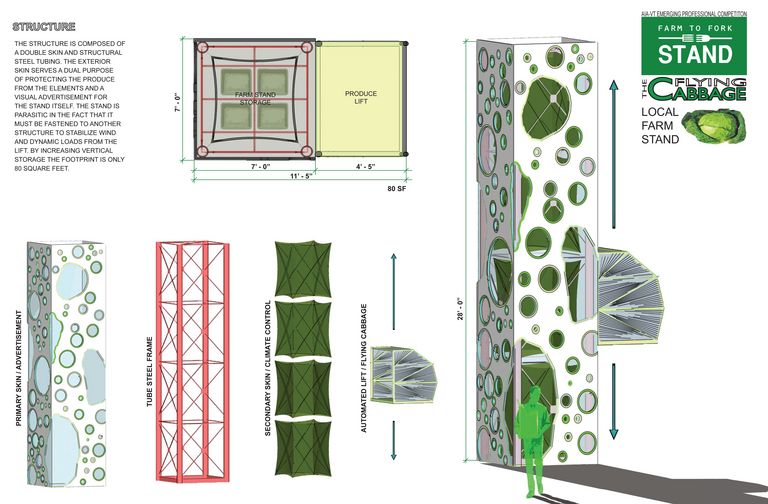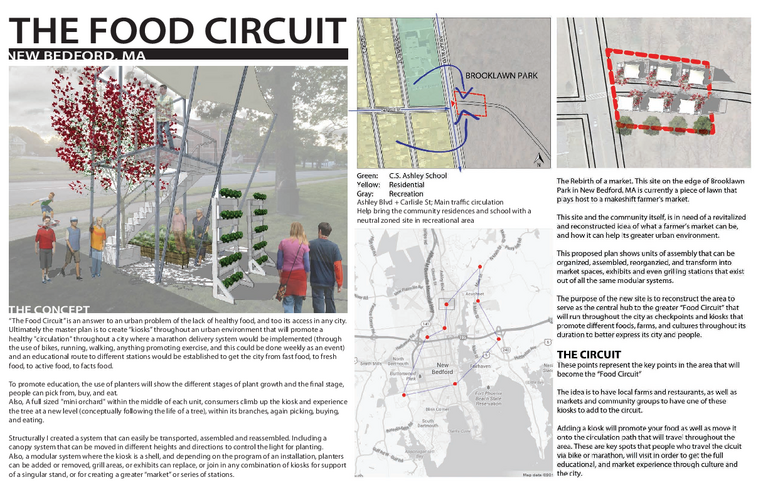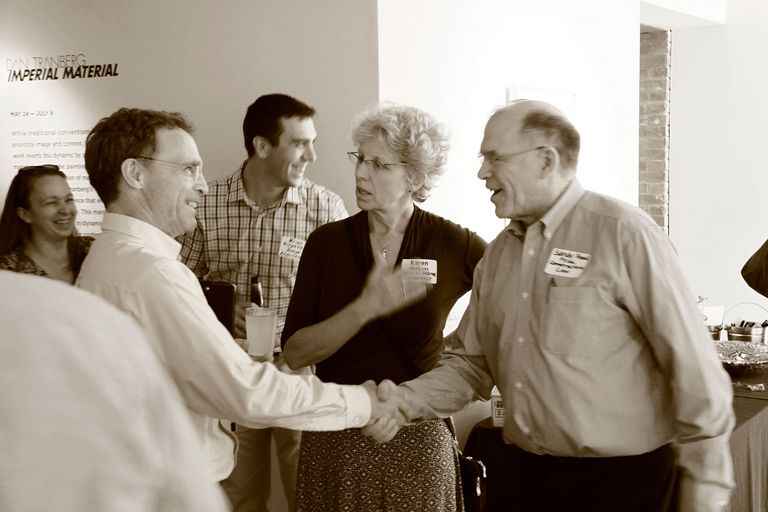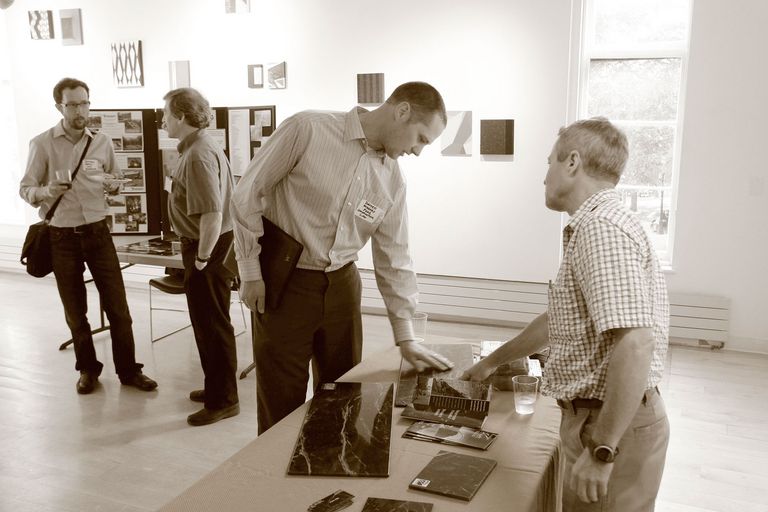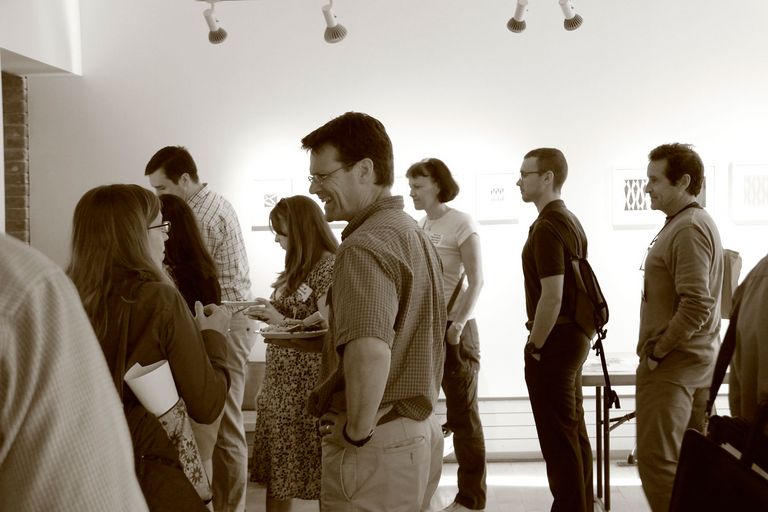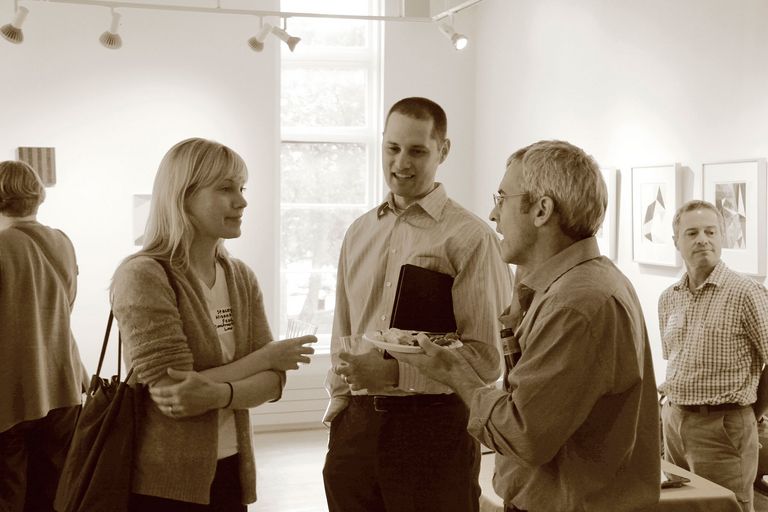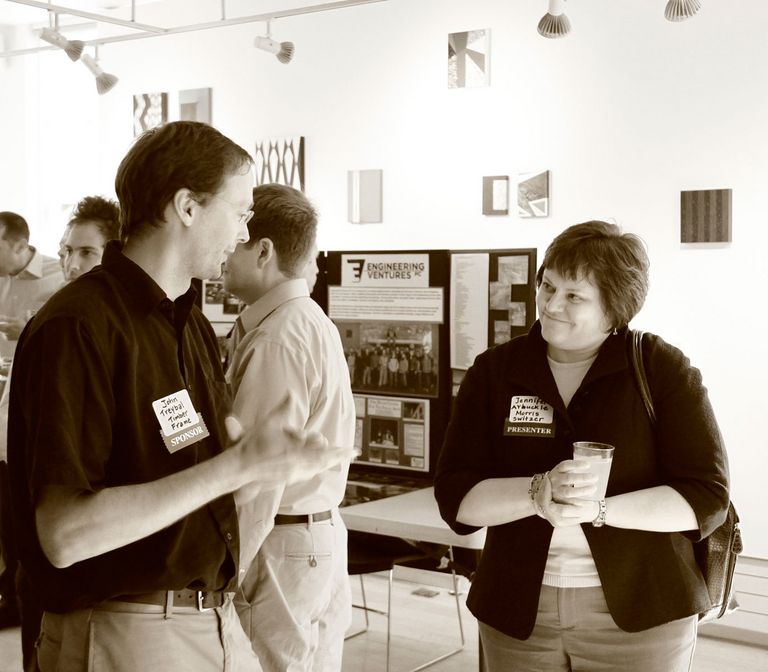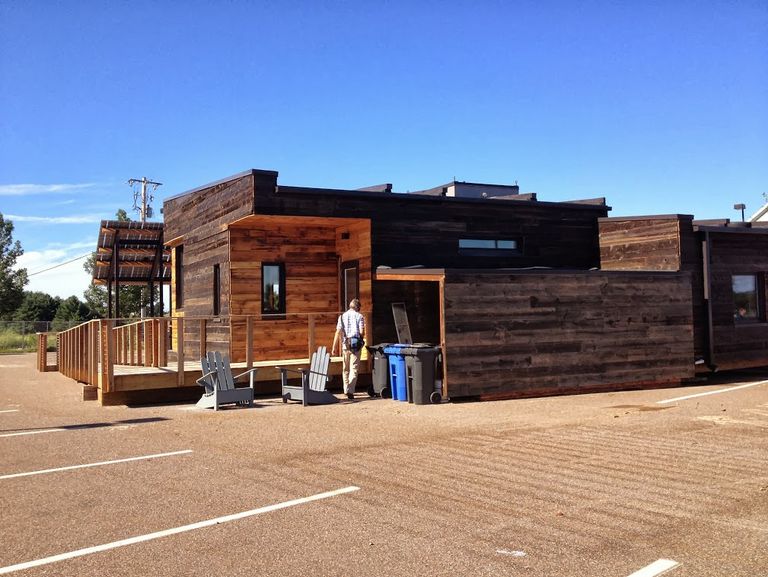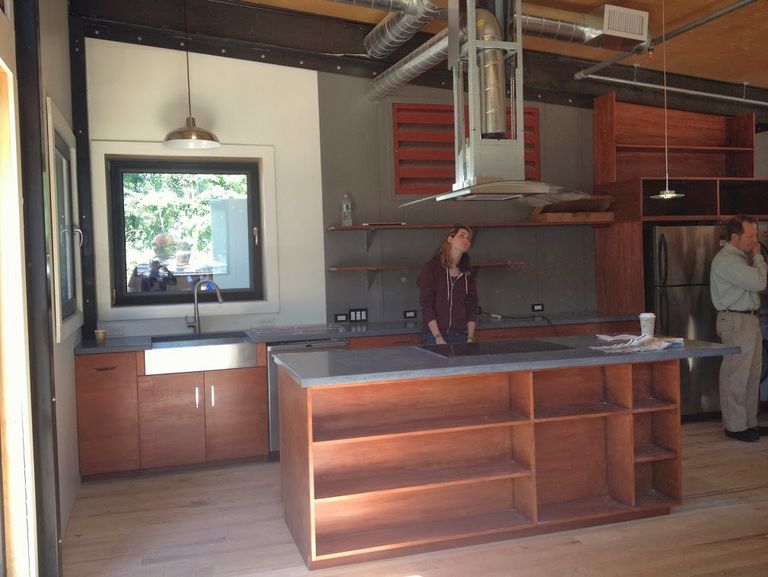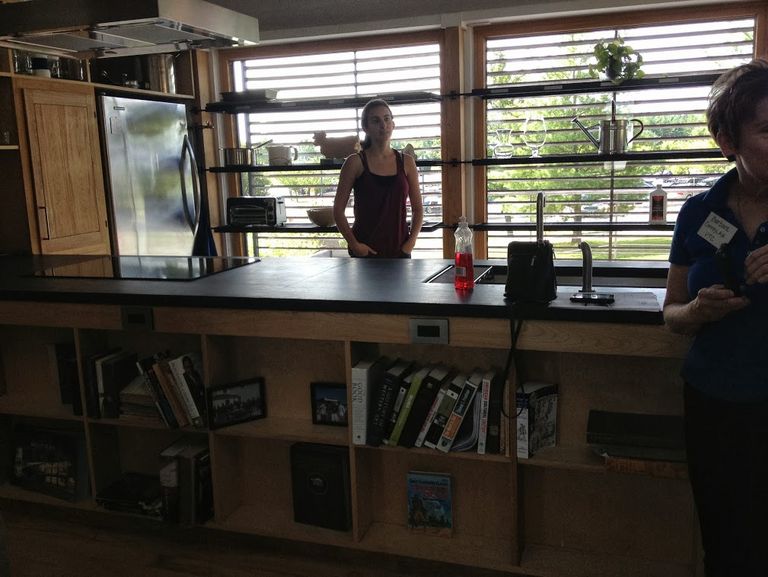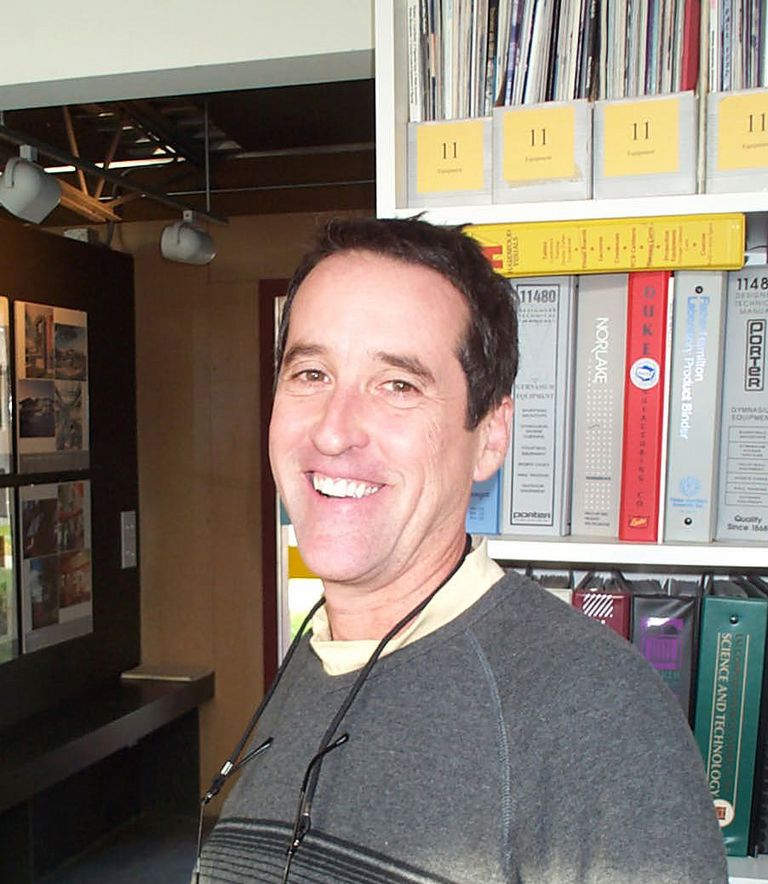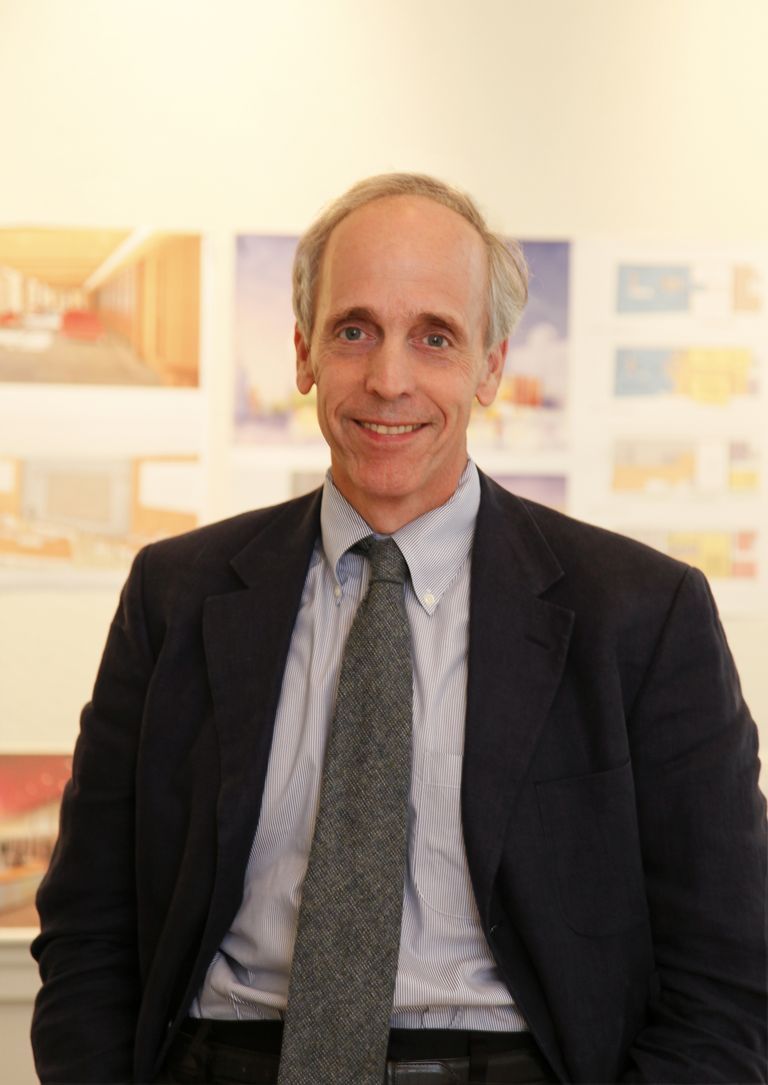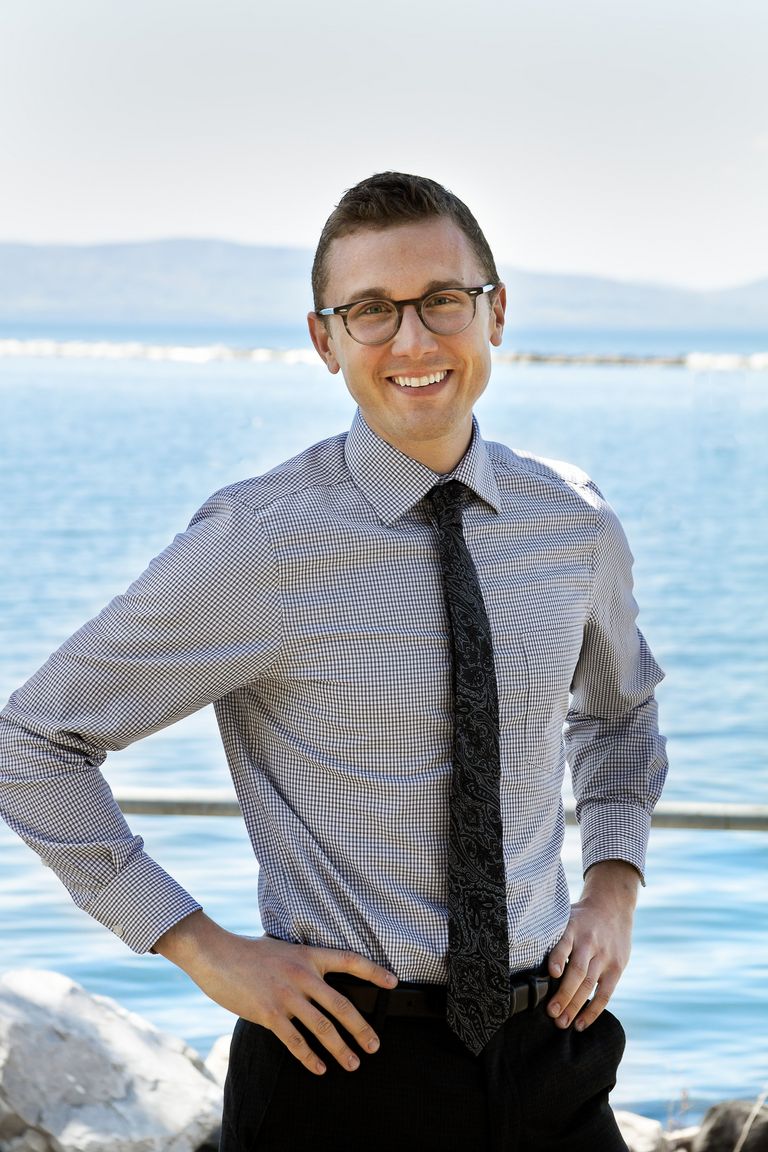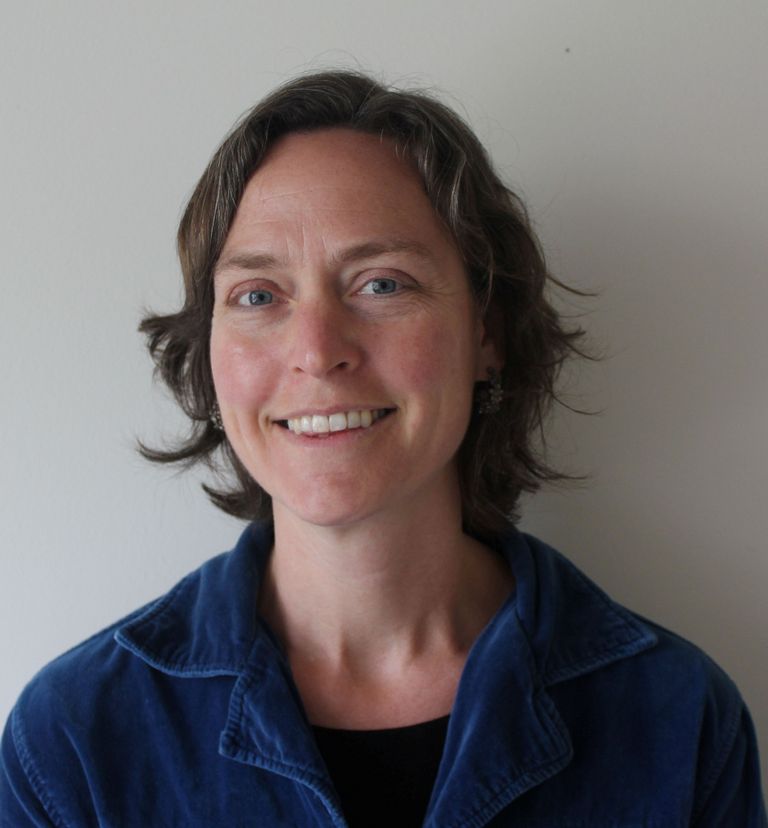9.13 AIAVT News

AIAVT-EPN Announces Winners of “Farm to Fork” Competition
The always well-attended Waitsfield Farmers’ Market was the fitting site of AIAVT’s Emerging Professionals Network (EPN) Design Awards exhibition on June 14. More...
from the PRESIDENT
2013 AIA National Convention Focuses on Building Leaders
In June, I had the good fortune to join fellow members at the AIA National Convention and Design Exposition held in Denver. The theme, “Building Leaders,” was borne of a commitment to spark a national discussion about the value of architecture More...
AIAVT-EPN Announces Winners of “Farm to Fork” Competition
The always well-attended Waitsfield Farmers’ Market was the fitting site of AIAVT’s Emerging Professionals Network (EPN) Design Awards exhibition on June 14. More...
BIM Software Discussion Draws Over 50 Attendees
AIA Vermont’s summer program season began on May 30 with a panel discussion titled “B.I.M: A New Drawing Paradigm?” More...
Recycled Newspaper & Flax Among Innovative Materials Used in Solar-Powered Houses Featured on AIAVT Tours
On July 25, AIA Vermont’s recently formed Energy + Environment Committee, in cooperation with Efficiency Vermont, offered its first event: tours of 1,000 sq. ft. solar-powered houses and biomass gasification plants at Middlebury College and Norwich University. More...
Who Can Call Themselves an Architectural Designer? Getting Clear on the Law
Undoubtedly, all AIA members are well aware that until becoming licensed to practice architecture, individuals may not legally call themselves “architects.” Some members may not know, however, More...
AIAVT-EPN Announces Winners of “Farm to Fork” Competition
The always well-attended Waitsfield Farmers’ Market was the fitting site of AIAVT’s Emerging Professionals Network (EPN) Design Awards exhibition on June 14. The “Farm to Fork” competition, eligible to New England-based designers as well as architects licensed five years or less, called for entrants to design a “practical and symbolic center for the local food system in a New England community.” The centers were to “engage with the existing local food system” and help promote local products, farms, and restaurants through displays, events, and other mechanisms.
“Physically, the Farm to Fork centers were required to have a maximum footprint of 100 square feet and be no more than 30 feet in height,” explained AIAVT-EPN Director Joshua Chafe, Assoc. AIA, a designer employed by TruexCullins of Burlington. “Temporary extensions designed to accommodate special events were allowed,” he added.
The competition attracted five entrants; Chafe said he was pleased about this number for a first-time annual competition that was conceived to be small, approachable, and appropriate for the time and place. “Plans to expand next year are already being discussed,” he said.
Lemire’s project, “The Food Clock,” is a kinetic device designed for Pliny Park in downtown Brattleboro; it highlights the connection between food and time. “Each day the Food Clock rotates slightly, performing a full rotation annually. As it turns, horizontal cables wrap the central disc, creating a spatial framework. Farmers and home gardeners can apply colorful stitches that represent when they plant, transplant, and harvest. Each day, the temporal tapestry of the clock evolves, creating a dynamic record of the year, the community, and its food,” said Lemire.
About Lemire’s project, jurors Steve Kredell, AIA, McLeod Kredell Architects; Harry Hunt, AIA, Harry Hunt Architects; and Rolf Kielman, AIA, TruexCullins Architecture + Interior Design said, "This is a wonderfully poetic concept that operates on many levels. We appreciated the reinterpretation of the iconic clock...the town center. It’s a good educational…idea that focuses on information that was likely commonplace back in the day."

The award for second place was the result of a tie, with $375 given to each recipient. Keegan Carmichael, a graduate of Boston Architectural College employed by JSA Architects in Portsmouth, New Hampshire was one recipient. Taylor Kuliga, an intern at JM Booth and Associates in New Bedford, Massachusetts was recognized for his project titled “Food Circuit,” which he described as “an answer to an urban problem of the lack of healthy and fresh food, culture, and community." He added "I saw this competition as an opportunity to…create something that could bring the diverse cultures and foods throughout the entire city together not only for business and promotions, but for people and community.”
If you are interested in participating in the EPN, a group for architects licensed less than 10 years as well as not yet licensed designers and graduate students enrolled in accredited programs, visit the Emerging Professionals page, find AIAVT-EPN on Facebook at www.facebook.com/aia.VT.ep or email aiavt.ep@ gmail.com for more information and to be placed on the AIAVT-EPN email distribution list. AIAVT-EPN is aligned with AIA National’s Center for Emerging Professionals and the National Associates Committee. The purpose of the group is to foster the career development of local emerging professionals through networking, learning opportunities and community involvement.
BIM Software Discussion Draws Over 50 Attendees
By Kevin Racek, AIA
AIA Vermont’s summer program season began on May 30 with a panel discussion titled “B.I.M: A New Drawing Paradigm?” The event, held at the Burlington City Arts Center, featured a lively exchange among over 50 Vermont architects, design professionals, and their colleagues that explored how Building Information Modeling (i.e., B.I.M.) is changing the way architects, contractors, and their clients think about design and building architecture.
During the discussion, topics included how particular software is affecting the profession in terms of drawing, design, project and staff management, client and contractor expectations, and budgets. The panelists, Jennifer Arbuckle, AIA, MorrisSwitzer Environments for Health; Joseph Cincotta, AIA, LineSync Architecture; Stephen Frey, AIA, Arocordis Design; and Justin Yandow, DEW Construction brought varied and interesting perspectives to the discussion, based on differences in the size and type of their practices. Collectively, attendees discovered that no two firms approach BIM in a similar way.
AIA National has recently issued several new documents and new contract forms to help establish Level of Design for BIM services. See them here.
Recycled Newspaper & Flax Among Innovative Materials Used in Solar-Powered Houses Featured on AIAVT Tours
On July 25, AIA Vermont’s recently formed Energy + Environment Committee, in cooperation with Efficiency Vermont, offered its first event: tours of 1,000 sq. ft. solar-powered houses and biomass gasification plants at Middlebury College and Norwich University. Houses at both campuses are entries in the U.S. Department of Energy’s 20-team international collegiate solar decathlon house competition, which this year is being held in California. Approximately 30 architects, engineers, contractors, and members of the public attended.
The tour began in the morning at Middlebury College, where attendees toured both the nearly-ready 2013 “In-Site House” and the fourth-place winning 2011 “Self-Reliance House” solar decathlon competition entries. Middlebury senior Gwen Cook, architecture student and project leader for the In-Site House, led the tour. Attendees had the opportunity to compare distinct differences between the two buildings—from energy systems and design to handicap accessibility, livability, and affordability. Attendees learned about the critical choices the Middlebury students had to make in designing the houses to travel by rail to the site of the competitions. In the case of the In-Site house, complex decisions were made regarding the use of a “sun path” entry, and the desire for the house to become a locally affordable residence when it is shipped back to Vermont.
Biomass Plant Manager Kelly Boe, an engineer, led the tour through the Middlebury College biomass plant and discussed the institution’s campus energy plan and sustainable forest harvest strategies. Attendees also learned about the benefits and disadvantages of biomass as an alternate fuel source and how it may help achieve carbon neutrality.
After a brief lunch stop at the nearby A&W, participants made their way to Norwich University for the second part of the tour, no less interesting than the first half. Under the guidance of Project Leader Matt Lutz, AIA, students in Norwich’s School of Art + Architecture presented their “Delta-T90” entry for the solar decathlon house competition. Students described their challenges and decisions regarding energy sources and materials, and how these were reflected in the final building design. They needed to consider the requirements of Energy Star appliances as well as appropriate windows, doors, and MHVE systems for our northeast climate.
A presentation about the campus biomass plant, which is under construction, was given by Shawn Brennan, AIA, of Freeman French Freeman and Tom Whitney of Vermont Mechanical. The institution’s plant manager then led a tour of the construction site and discussed boiler choices, codes and regulations, energy-efficiency paybacks, and overall campus energy planning.
“It was great to see architects exchanging ideas with students on a variety of subjects, including design details, volumetric and spatial choices, and technical decisions related to the three decathlon projects. We AIA members were very impressed to see the commitment and leadership these twenty-year olds had for the research, fundraising, and overall energy it takes to enter a competition such as DOE’s. Their keenness for innovation and exploration set an example for all of us,” said E+E Chair Diane Gayer, AIA, Vermont Design Institute.
AIAVT thanks the event underwriter, Efficiency Vermont, and site sponsors R.K. Miles and Vermont Heating and Ventilating for helping to make this event a success.
Who Can Call Themselves an Architectural Designer? Getting Clear on the Law
Undoubtedly, all AIA members are well aware that until becoming licensed to practice architecture, individuals may not legally call themselves “architects.” Some members may not know, however, that it is also against Vermont law to refer to oneself as an “architectural designer” or claim to offer “architectural design services” before becoming licensed. Our state is not alone in the restriction of such language: the same holds true in most other states. State law, in fact, governs issues around professional licenses, not AIA policies.
According to the Vermont Statutes, Title 26: Professions and Occupations, Chapter 3: (ARCHITECTS), § 122. (a) (2), no person shall “Use in connection with the person's name any letters, words, title, or insignia indicating or implying that the person is an architect unless the person is licensed in accordance with this chapter.” The “chapter” in this statute refers to the state.
According to Edward Wolfstein, AIA, NCARB, MRAIC, CSI, Chair, Vermont Board of Architects (VBOA), this means “the use of any derivative of the word architect that might mislead the public into thinking they would be purchasing services from a licensed architect professional is not permissible.” While it might irk many architects that the word “architect” and its variants are permissible in the context of other professions or services, it is allowed in such cases because there would be no issue of misinterpretation by the public.
Wolfstein says, “Certainly a ‘software architect,’ a term commonly used these days, would not be confused to be a licensed architect. So, it really is the context at hand where this becomes critical.” Frank Guillot, FAIA, a former president of both AIAVT and NCARB, adds “You can call yourself a house designer or a building designer, but as soon as you or your firm says you provide ‘architectural design services,’ in the eyes of the law, you’d better be licensed.”
Wolfstein says that the state does not have the manpower to actively police individuals who are illegally using a term such as “architectural designer.” The VBOA relies on others, he says, “such as ourselves as architects, our clients, or anyone really, to bring these issues to their attention. A complaint needs to be filed with the state, prompting an investigation. Depending on the facts uncovered during the investigation, the party in violation can be cited for an infraction of the law, or given a warning. Usually, such warnings are enough. In some cases, matters will go to the next level—the invoking of fines. In very rare cases, criminal litigation will result.”
If you wish to notify the State of Vermont about individuals or firms that might be wrongly using the word architect or its variants (e.g., on a Web site, business card, social media site or office signage), contact Danielle Rubalcaba at (802) 828-1501. To get further clarification regarding the law, contact Edward Wolfstein at ed@ wastudio.com.
AIAVT “Archistream” Concept Earns Chapter Major Grant
In August, AIA Vermont learned that our Chapter had been awarded a $42,750 grant from AIA National’s Innovation Fund for a proposal to create a mobile design and education center in a refurbished Airstream trailer. The idea came out of a brainstorming session, largely led by Diane Gayer, AIA, Vermont Design Studio and Aron Temkin, AIA, Norwich University at this year’s AIAVT Board of Directors’ June retreat and was further honed during the grant writing process with help from Diantha Korzun, AIA, TruexCullins and Carol Miklos, AIAVT’s executive director.
The AIAVT award was the highest amount received by any AIA Chapter and just eight grants were made from a pool of 65 applicants. The grants are being given out as part of the AIA Repositioning Initiative. The Repositioning Ambassadors responsible for choosing the grant recipients felt that our project, currently referred to as the “Archistream,” squarely met their definition of innovative, plain and simple. They felt that the program’s public relations value was not couched in the social media or digital campaigns people have come to expect these days, but rather in good, old fashioned face time—something they tagged as positively disruptive.
An Archistream project management team composed of Gayer, Korzun, AIAVT-EPN Director Josh Chafe, Truex Cullins; and Norwich University Assistant Professor of Architecture Tolya Stonorov has already had productive discussions. Stonorov will lead a group of students in a design/build studio that will customize the trailer to the management team’s specifications and program needs. Students will work on the project during the spring 2014 semester; the goal is to see the trailer launched next summer. A comprehensive news story about the mobile design and education center—which will be for members’ benefit and use throughout Vermont—will run in the next issue of the newsletter.
To read more about the grant award process and Vermont’s proposal, visit http://www.aia.org/about/repositioning/AIAB099746?dvid=&recspec=AIAB099746. Be sure to scroll down to the bottom for the specific description of the AIAVT project.
ANNOUNCEMENTS
Vermont Verde Antique, LLC, a serpentine stone quarry in Rochester, Vermont, is preparing to welcome the Marble Institute of America’s quarry tour for stone professionals in early October.
“This is the third time we have been part of the quarry tour. We are excited to show our industry peers how we are opening up a new quarry face, which will ensure the quarry is able to supply stone to architects and designers for many more decades. Returning visitors will notice a significant change in the area surrounding the quarry,” said quarry owner Thomas Fabbioli.
After tropical storm Irene, the quarry supplied stone from decades-old-debris piles to rebuild road beds and shore up river banks. The result is improved on-site infrastructure, and the use of what would have been waste stone, to improve Vermont’s infrastructure.
Serpentine is often mistaken for marble or granite, but in fact has the desirable qualities of both. The Rochester quarry’s dark green serpentine is sought for its white and light-green veining, and often contains subtle, layered, metallic highlights. Unlike marble, serpentine is resistant to etching by acids, and is as hard as some granite types.
Vermont Verde Antique serpentine is used for residential countertops and throughout commercial buildings. Recent projects include the Plaque Gallery at the Baseball Hall of Fame in Cooperstown, New York, the exclusive Bay Club in San Francisco, and the Buffalo, New York Federal Court House. For more information, visit www.vtverde.com or contact angelique@ vtverde.com.
Calendar
10/2 AIA Vermont AIA New Hampshire Joint Meeting Dartmouth College in Hanover, NH Register
10/11 Passive House Symposium 2013, Judd Hall, VTC, Randolph
10/17 AIA Vermont Building Tour: Pizzagalli Center for Art and Education, Shelburne Museum, Shelburne
12/5 AIAVT Annual Meeting and Design Awards Presentation Vermont Statehouse, Montpelier
from the PRESIDENT
2013 AIA National Convention Focuses on Building Leaders
In June, I had the good fortune to join fellow members at the AIA National Convention and Design Exposition held in Denver. The theme, “Building Leaders,” was borne of a commitment to spark a national discussion about the value of architecture and the critical role architects play as visionary leaders in making the world a better place.
Recapping the sessions and conveying the enthusiasm evident at the convention is difficult to do in a newsletter article. Over a three-day period, I mingled with and learned from thousands of architects and design professionals united by the idea that design has the power to change the way we live and a shared belief in the capacity of architecture—and architects—to touch people around the world.
Throughout the event, we were urged to consider the following:
- In creating public and private spaces, our design can inspire people to think far beyond what mankind has been done before.
- When considering the wide-reaching power of design, who is leading the conversation? Who is defining the agenda?
- The answer to the questions above should be “us”—architects must embrace the role of leader, in partnership with those who share our values, our visions, and our aspirations.
- Thoughtful leadership, a commitment to advocacy, and effective communication are all tools through which we can expand the appreciation of our field and increase public understanding of creative opportunities.
- In order to effectively lead communities towards positive change, architects must encourage optimism and cultivate the desire to serve.
The convention gave me an opportunity to get an update on the AIA Repositioning Initiative. Some of the news we’ve heard before—research shows that the public likes and respects architects but doesn’t truly understand what we do or the impact we can make. In an effort to address this issue, the Repositioning Initiative will enlist emerging professionals and utilize their energy to reach out to the public and succinctly explain the value of design. As AIA President Mickey Jacob, FAIA, stated, “This is a new era for us to start moving forward as leaders with enthusiasm, passion, and energy, showing not just our colleagues but our communities who we are, what we want to be, and why we, as architects, are key to making our communities better places to live.” AIA’s focus on communicating the value of design will continue throughout 2013.
Three keynote speakers, all inspiring and very different from each other—were a highlight of the convention. Blake Mycoskie, founder of Tom’s Shoes and subsequently the “One for One” movement, gave a philanthropic-based presentation. Tom’s Shoes has given over two million pairs of new shoes to children in need since the formation of the company in 2006. Mycoskie’s recent book, Start Something That Matters, addresses how philanthropy and profit can work together. He discussed his vision of humanitarian-based entrepreneurial leadership—urging us to act as leaders in our firms and communities. He believes in the power of inspiring young people—in AIA’s case, emerging professionals—to help make the future brighter, by encouraging them to include giving in everything they do.
Cameron Sinclair, co-founder and CEO of Architecture for Humanity, a nonprofit organization focused on seeking architectural solutions to humanitarian crises and bringing professional design services to communities in need, gave the second keynote. Architecture for Humanity grew out of the founders’ desire to “leave the world better than we found it,” he said. The organization assists disaster-devastated communities, locally and internationally, and uses design to create lasting change in these communities. The author of Design Like You Give a Damn, Sinclair sustains his passion for improving the world, one project at a time, by tapping in to the enthusiasm of like-minded architects around the globe.
The closing keynote speaker was retired four-star general General Colin Powell, founder of the Colin L. Powell Center for Leadership and Service, an organization focused on developing a new generation of publicly engaged leaders. He urged us to believe in, invest in, and set high expectations for ourselves. Powell also detailed the risks and rewards of being a leader—challenging us to return to our communities with a renewed desire to lead.
As I made my way home to Vermont, I could not help but carry back with me a high level of enthusiasm regarding our profession and those who practice it. I was motivated by the keynote speakers, new acquaintances, and old college friends from across the country. Realizing that we’re all striving toward a common goal was an empowering experience. If you’ve never attended the AIA National Convention, I recommend that you consider it in the future.
Best Regards,
Tom
Tom Bachman, President, AIAVT
new MEMBERS
Architects
James Beasley, AIA, recently moved to Vermont and joined Black River Design Architects. Once a carpenter for a green-building company in his home state of Maine, Beasley later studied design at the University of Oregon. Throughout his career, his focus has been on creating energy-efficient, affordable spaces that seek to improve the human experience of the built environment. He has extensive experience in sustainable design and building, providing insight into their technical aspects, feasibility, and practicality. He has worked on a broad range of projects, including academic, residential, commercial, civic, and infrastructure planning.
Associates
Sam Beall, Assoc. AIA, is an Enterprise Rose Architectural Fellow working on affordable senior housing in Vermont. His host organization, Cathedral Square Corporation, has provided safe, healthy, and affordable homes for seniors in Vermont since 1979. He studied architecture at the University of Virginia, earning a bachelor’s degree in 2004 and a master’s degree in 2009; he investigated sustainable senior housing for his master’s thesis. Beall worked at architecture firms in New York City and San Francisco before moving to Vermont to work with Cathedral Square.
Robert Jimenez, Assoc. AIA, recently joined TruexCullins’ Home and Education Studios. Previously, he worked for several design firms in Philadelphia, where he also served on the board of the Northern Liberties Urban Design Committee and was an associate member of AIA Pennsylvania. He earned his bachelor’s degree in architecture from Virginia Polytechnic Institute and State University. An elite-class mountain bike racer for the past 11 years, Jimenez recently joined Burlington’s Fellowship of the Wheel. He lives in Burlington’s Old North End with his fiancé and their English bulldog.
latest ACHIEVEMENTS
William Brothers, Assoc. AIA, has been promoted to associate at MorrisSwitzer~ Environments for Health, where he focuses on design. He has a broad range of experience in medical and rehabilitation facilities, from new construction projects to renovations and additions.
Keith Krause, AIA, of MorrisSwitzer~ Environments for Health, has been promoted to senior associate. Krause has 22 years of professional experience as a project manager on a variety of projects, including new and remodel construction.
Jennifer Lane-Colbert, AIA, has been made senior staff architect at MorrisSwitzer~ Environments for Health. Proficient in AutoCAD, Revit, and BIM, Colbert has contributed to Planned Parenthood, Eastern Maine Medical Center, and other projects.
The CSI Sustainable Design and Construction Practice Guide, published by Wiley, is being showcased at the USGBC GreenBuild 2013 conference in November. Jonathan Miller, AIA, is a contributing author (Chapter 1.4, “Green Building Rating Systems” and Chapter 4, “Green Product and System Evaluation”). See http://www.wiley.com/WileyCDA/WileyTitle/productCd-1118078551,descCd-description.html to find the book.
Kimberly Wilson, AIA, has been promoted to senior staff architect at MorrisSwitzer~ Environments for Health. Her projects have included large scale hospitals and medical office buildings and she has been an office leader for MorrisSwitzer in the LEED certification process.
An article written by Valeriano Zarro, AIA, “Why Green Isn't Enough,” has been published by EDC, “the official magazine for the LEED professional.” Visit http://www.edcmag.com/articles/95131-why-green-isnt-enough to read it.
AFFIFIATE News
NEW MEMBERS
Vantem Panels, America's original SIP manufacturer, has been delivering high quality SIPs and nail base panels throughout the world since 1981. R-values ranging from R15 to R50 with EPS and Urethane are available from the Brattleboro-based company. Users can reach NZE with Vantem’s product. Contact: Brice Hereford, Registered Sustainable Designer, 802-254-3435, 802-275-8122(cell), www.vantempanels.com, brice.hereford@ vantempanels.com
AIAVT News is published by AIA Vermont, a Chapter of the American Institute of Architects.
Opinions are the author’s and not necessarily the views of AIAVT or any other organization.
AIAVT reserves the right to edit articles for available space and determine appropriate content prior to inclusion. Submissions must be received by the 15th of the month prior to publication.
For advertising rate and specifications, see our Media Kit.
Please send articles, notices, letters, and graphic submissions to the editor:
Carol Miklos, Executive Director, AIA Vermont
88 Blackbird Lane
Charlotte, Vermont 05445
802-425-6162

